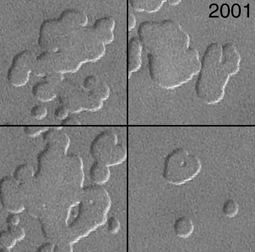Guest contribution by Steinn Sigurdsson.
Recently, there have been some suggestions that “global warming” has been observed on Mars (e.g. here). These are based on observations of regional change around the South Polar Cap, but seem to have been extended into a “global” change, and used by some to infer an external common mechanism for global warming on Earth and Mars (e.g. here and here). But this is incorrect reasoning and based on faulty understanding of the data.

A couple of basic issues first : the Martian year is about 2 Earth years (687 days). Currently it is late winter in Mars’s northern hemisphere, so late summer in the southern hemisphere. Martian eccentricity is about 0.1 – over 5 times larger than Earth’s, so the insolation (INcoming SOLar radiATION) variation over the orbit is substantial, and contributes significantly more to seasonality than on the Earth, although Mars’s obliquity (the angle of its spin axis to the orbital plane) still dominates the seasons. The alignment of obliquity and eccentricity due to precession is a much stronger effect than for the Earth, leading to “great” summers and winters on time scales of tens of thousands of years (the precessional period is 170,000 years). Since Mars has no oceans and a thin atmosphere, the thermal inertia is low, and Martian climate is easily perturbed by external influences, including solar variations. However, solar irradiance is now well measured by satellite and has been declining slightly over the last few years as it moves towards a solar minimum.
So what is causing Martian climate change now? Mars has a relatively well studied climate, going back to measurements made by Viking, and continued with the current series of orbiters, such as the Mars Global Surveyor. Complementing the measurements, NASA has a Mars General Circulation Model (GCM) based at NASA Ames. (NB. There is a good “general reader” review of modeling the Martian atmosphere by Stephen R Lewis in Astronomy and Geophysics, volume 44 issue 4. pages 6-14.)
Globally, the mean temperature of the Martian atmosphere is particularly sensitive to the strength and duration of hemispheric dust storms, (see for example here and here). Large scale dust storms change the atmospheric opacity and convection; as always when comparing mean temperatures, the altitude at which the measurement is made matters, but to the extent it is sensible to speak of a mean temperature for Mars, the evidence is for significant cooling from the 1970’s, when Viking made measurements, compared to current temperatures. However, this is essentially due to large scale dust storms that were common back then, compared to a lower level of storminess now. The mean temperature on Mars, averaged over the Martian year can change by many degrees from year to year, depending on how active large scale dust storms are.
In 2001, Malin et al published a short article in Science (subscription required) discussing MGS data showing a rapid shrinkage of the South Polar Cap. Recently, the MGS team had a press release discussing more recent data showing the trend had continued. MGS 2001 press release MGS 2005 press release. The shrinkage of the Martian South Polar Cap is almost certainly a regional climate change, and is not any indication of global warming trends in the Martian atmosphere. Colaprete et al in Nature 2005 (subscription required) showed, using the Mars GCM, that the south polar climate is unstable due to the peculiar topography near the pole, and the current configuration is on the instability border; we therefore expect to see rapid changes in ice cover as the regional climate transits between the unstable states.
Thus inferring global warming from a 3 Martian year regional trend is unwarranted. The observed regional changes in south polar ice cover are almost certainly due to a regional climate transition, not a global phenomenon, and are demonstrably unrelated to external forcing. There is a slight irony in people rushing to claim that the glacier changes on Mars are a sure sign of global warming, while not being swayed by the much more persuasive analogous phenomena here on Earth…
[…] Mars does appear to be experiencing short-term regional warming, not long-term global warming, as the climate scientists of Realclimate.org have explained. […]